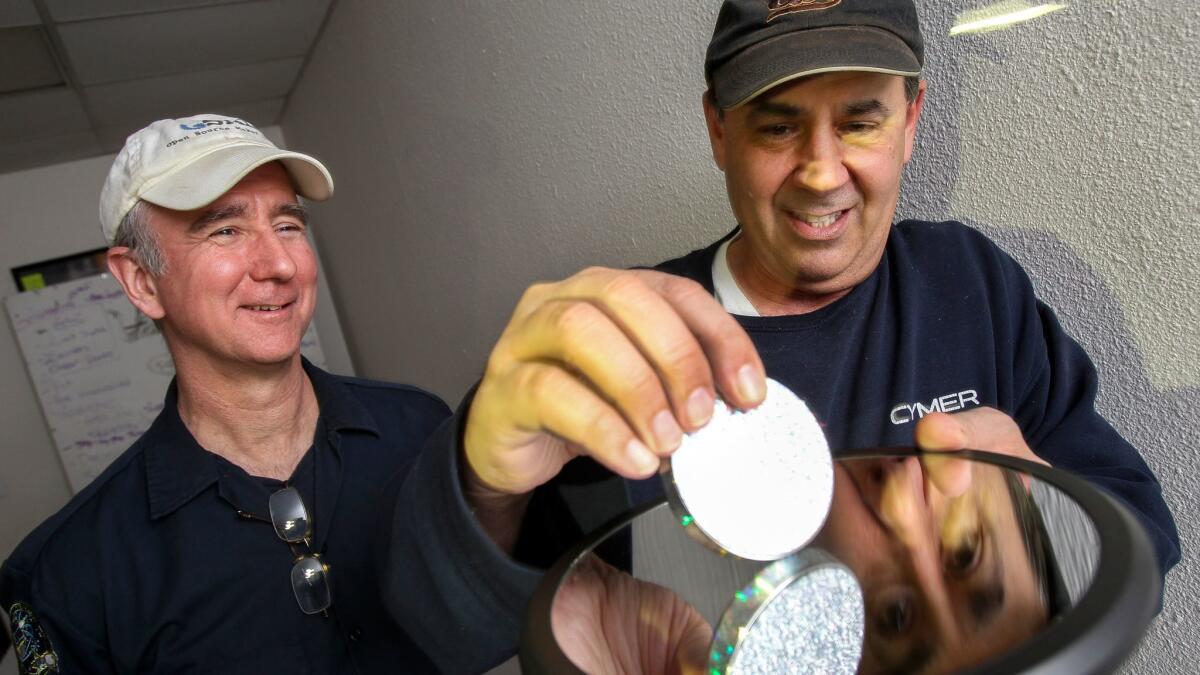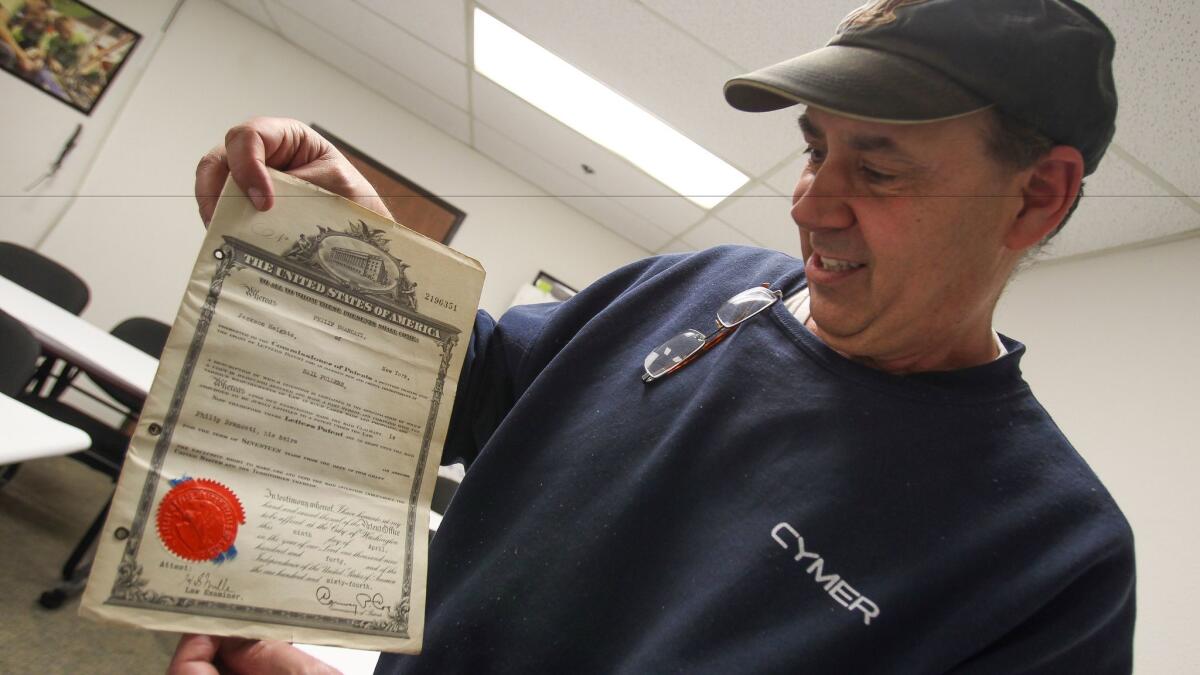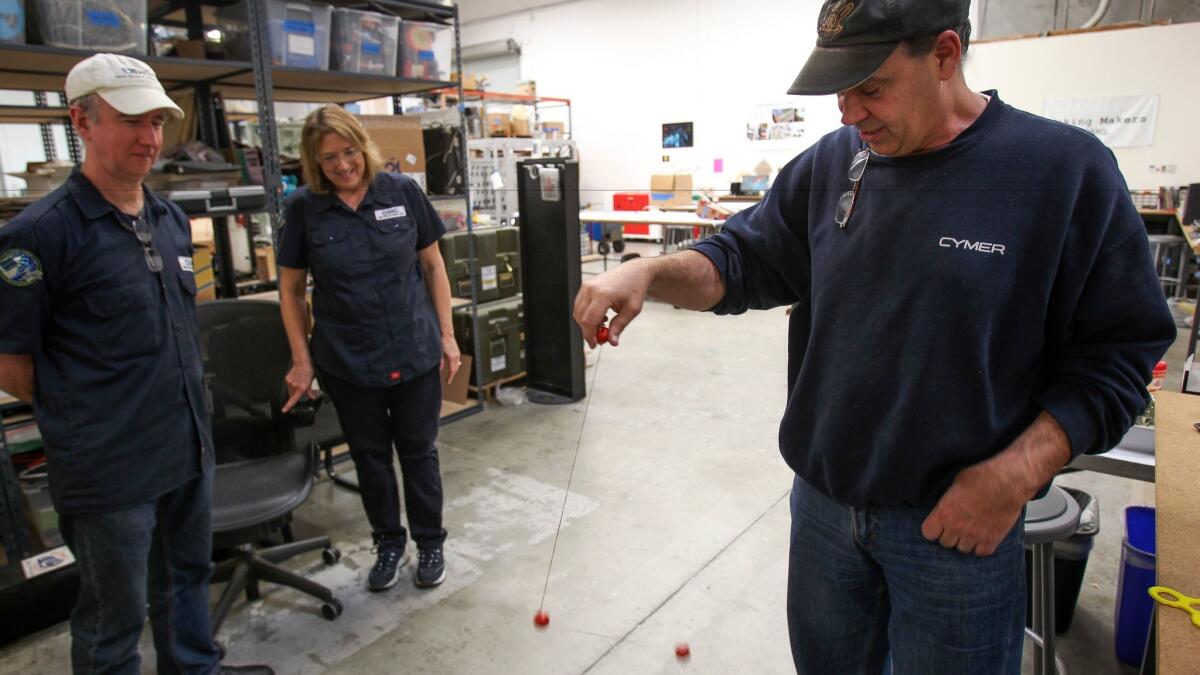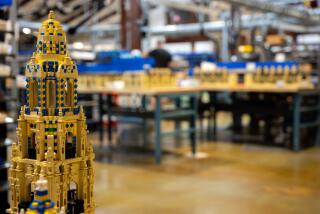‘Big Bang’ gives Escondidan’s physics toy a spin
- Share via
Thanks to the lovable geeks on TV’s “The Big Bang Theory,” an Escondido inventor’s decades-old toy is now spinning with new life.
On the popular show’s Feb. 16 episode, astrophysicist Raj tried to hold his breath longer than it took for the science toy known as Euler’s Disk to stop spinning.
To the disappointment of petulant physicist Sheldon and his nerdy friends, Raj outlasted the disk’s 90-second spin. But his lung power’s got nothing on the actual longevity of the holographic toy. Escondido inventor Joe Bendik has been selling around 1,000 disks a year since they came on the market in 1996.
The disks have been a steady, though small, source of extra income over the years. So Bendik was astonished when he opened his email on the morning of Feb. 17 and found hundreds of order requests from all over the country.
“It was flooded,” he said. “I thought I’d opened up the spam folder by accident.”

Although he’s a fan of “The Big Bang Theory,” Bendik hadn’t seen the episode and he had no idea the disk was going to be used on the program. He ended up having to refund hundreds of orders that week because he didn’t have enough supply on hand to meet the demand.
Now he’s hoping to build on renewed interest in the Euler’s Disk by hosting monthly “Inventors Corner” events at the Open Source Maker Labs in Vista.
He hopes to work with young science-lovers on bringing several of his other science-themed toy ideas to market. Not only could it generate a little extra income — he and his wife, Debra, have two college-age sons — but he’s a longtime volunteer and promoter of interactive science learning.
“Hands-on work is important,” said Bendik, 57, a research engineer for Cymer in Rancho Bernardo. “It leads to all kinds of things outside the realm of the university. It gives you a better appreciation for how things can be done, supplements your education and makes you more valuable.”
Inventing runs in Bendik’s blood. His grandfather held a patent and he started his own experimention at age 13, when he and his geometry classmate Larry Shaw began developing their own ideas after school.

Shaw went on to earn a physics degree at Cornell University and invented the Astrojax, a yo-yo-like lasso with three weighted balls on a string. Bendik went to UC Berkeley where he earned a physics degree and ended up at Hughes Aircraft in Carlsbad. It was there, around 1987, when the inspiration for the Euler’s Disk struck.
One afternoon, a box of heavy polishing chucks (which resemble steel hockey pucks) arrived in his lab. He always enjoyed coin-spinning, so just for fun he gave one of the chucks a spin on his desk.
He was amazed by how long it could “spoll” (a combination of spin and roll) before falling flat and how some of the chucks produced a whining sound that continually rose in pitch the longer they spolled.
Over the next several years, he experimented with different size disks, different weights, different coatings and different spinning surfaces (a mirrorlike glass produces the longest spoll). The he discovered if he added a holographic sticker on top, a spherical illusion would appear as the disk turned.
The final step was giving the toy an interesting name. He chose Euler’s Disk, named for the Leonhard Euler (pronounced “oiler”), an 18th-century Swiss physicist and mathematician who was interested in spolling.
The Euler’s Disk was first introduced at The Nature Stores in shopping malls. These days it’s sold online. Washington distributor Toysmith sells them for $35 plus shipping on Amazon.com.
Last months’ “Big Bang” mention wasn’t the first time Euler’s Disk had a brush with fame. In 2000, an article in the weekly scientific journal Nature compared the disk’s rising sound as an example of the “finite-time singularities” of black holes. The disk was also featured in a couple of movies, including 2001’s “Pearl Harbor,” where sound designers used the toy’s characteristic whirr to represent the motor on Japanese torpedoes.

Although Bendik has come up with hundreds of inventions, the Euler’s Disk is the only toy he’s had the time and money to bring to market. With this new burst in sales, he’s hoping to use that momentum to publish a long-incubating book of inventions.
Several toys have made it to the prototype stage, including the Bubble Lab, a viewing device that examines thin film interference in soap bubbles. These half-finished projects are the ones he’s hoping to share with kids at his soon-to-launch Inventors Corner at the Open Source Maker Labs (OSML) in Vista.
OSML — at 2591 Pioneer Ave., Suite G, in Vista — was opened in October 2014 by Dan and Mary Alice Hendricks. The high-tech digital fabrication and 3D printing workshop hosts school robotics competitions and serves as a resource for aspiring inventors without the tools, space or expertise to bring their ideas to fruition.
Bendik has known Dan Hendricks for eight years because their sons attended middle school together. Over the years, the two men have volunteered together at school science olympiads, and Bendik has been a regular presence at OSML since it opened.
“He’s been a great inventor, he’s knowledgeable about science and physics and he loves sharing it with kids,” Hendricks said. “He’s always coming up with new analogies and ways to explain things.”
Bendik said he plans to have the Inventors Corner sessions once a month at OSML. He also plans to teach a class on problem solving, gaming and game-making. Hendricks said he can’t think of a better way to engage kids in science than invent toys.
“This is a way that you can get young people engaged in science education and they can have fun doing it,” Hendricks said.
Hendricks has also launched a collaboration with Wavelength Brewing, where science-lovers can meet each month for an evening of science and engineering talks, beer tasting and food from a local food truck. The next event is from 4-9 p.m. March 24.
For a full calendar of events at OSML, visit opensourcemakerlabs.com or call (760) 998-1522. The







